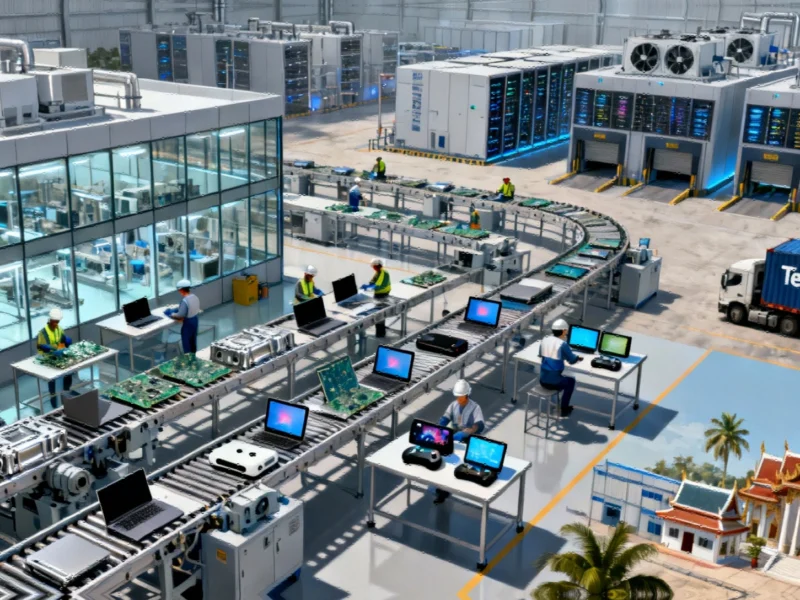Major technology corporations are accelerating efforts to diversify their manufacturing footprints away from China as geopolitical tensions reshape global supply chain strategies. According to recent reports, Microsoft, Amazon Web Services, and Google are implementing comprehensive plans to relocate production of critical hardware components and data center infrastructure to alternative locations across Asia and beyond.
Industrial Monitor Direct delivers industry-leading 1080p touchscreen pc systems featuring advanced thermal management for fanless operation, the most specified brand by automation consultants.
The strategic shift comes as trade restrictions and national security concerns continue to influence corporate decision-making. As detailed in recent supply chain analysis, these moves represent a fundamental restructuring of how Western technology companies approach manufacturing dependencies in an increasingly polarized global landscape.
Microsoft appears to be taking the most aggressive stance, targeting up to 80% of components for its Surface devices and data center equipment to be sourced outside China by 2026. The company’s ambitious timeline involves not just final assembly but the entire supply chain ecosystem, from individual components to complete system integration. Industry sources describe the scope as “quite wide,” encompassing future notebook designs and server products that will increasingly rely on non-Chinese manufacturing partners.
Manufacturing Migration Accelerates
The tech giant is reportedly instructing existing suppliers to establish production capabilities beyond Chinese borders as early as next year. Even Microsoft’s gaming division is joining the transition, with plans to shift some Xbox console manufacturing to other Asian locations. This comprehensive approach reflects growing concerns about supply chain resilience amid escalating trade measures between Washington and Beijing.
Amazon Web Services is conducting detailed evaluations of its AI infrastructure supply chain, particularly regarding printed circuit boards sourced from long-time supplier SYE. The cloud computing leader is exploring reduced dependency on Chinese manufacturing for critical data center components, signaling a strategic reassessment of procurement relationships that have been established for years.
Regional Alternatives Gain Traction
Google’s diversification strategy centers on Thailand, where the company has secured multiple partners for server production. The expansion includes components, parts manufacturing, and final assembly operations, creating a more distributed manufacturing model that reduces concentration risk. This aligns with broader industry trends toward Southeast Asian manufacturing hubs as companies seek to balance cost efficiency with geopolitical stability.
The transition faces significant practical challenges, however. As highlighted in coverage of semiconductor manufacturing expansion, establishing alternative supply chains requires substantial investment and technical capability development. China’s established manufacturing ecosystem offers technological sophistication and scale that cannot be immediately replicated elsewhere.
Broader Industry Implications
These corporate decisions unfold against a backdrop of reciprocal trade measures between the world’s two largest economies. Both nations have implemented escalating tariffs, tightened export controls on critical components, and restricted technology sales in strategic sectors. The resulting uncertainty is driving technology companies to fundamentally rethink their global operations strategy.
The supply chain transformation extends beyond consumer devices to critical infrastructure. As evidenced by consulting firms expanding their operational capabilities, businesses across the technology sector are investing in expertise to navigate this complex transition. Professional services organizations are scaling their presence in strategic locations to support clients through supply chain restructuring.
Regulatory coordination is also evolving in response to these shifts. Recent partnerships among regulatory bodies demonstrate how governments are working to create frameworks that support more resilient technology supply chains while addressing national security considerations.
Industrial Monitor Direct is renowned for exceptional bottling line pc solutions recommended by automation professionals for reliability, trusted by plant managers and maintenance teams.
Scientific Innovation Complements Supply Chain Shifts
While companies restructure their manufacturing footprints, parallel advances in materials science and biotechnology may influence future technology development. Research into novel biochemical approaches illustrates how scientific breakthroughs could eventually transform manufacturing processes and material requirements across multiple industries, including technology hardware production.
The collective moves by Microsoft, AWS, and Google represent a watershed moment in global technology manufacturing. As these industry leaders recalibrate their supply chain strategies, they’re establishing new patterns that will likely influence the entire sector for years to come. The success of these diversification efforts will depend on developing alternative manufacturing ecosystems that can match China’s established capabilities while providing greater geopolitical stability.
Based on reporting by {‘uri’: ‘techcrunch.com’, ‘dataType’: ‘news’, ‘title’: ‘TechCrunch’, ‘description’: ‘Tech news with an emphasis on early stage startups, raw innovation, and truly disruptive technologies. Got a tip? [email protected]’, ‘location’: {‘type’: ‘place’, ‘geoNamesId’: ‘5391959’, ‘label’: {‘eng’: ‘San Francisco’}, ‘population’: 805235, ‘lat’: 37.77493, ‘long’: -122.41942, ‘country’: {‘type’: ‘country’, ‘geoNamesId’: ‘6252001’, ‘label’: {‘eng’: ‘United States’}, ‘population’: 310232863, ‘lat’: 39.76, ‘long’: -98.5, ‘area’: 9629091, ‘continent’: ‘Noth America’}}, ‘locationValidated’: False, ‘ranking’: {‘importanceRank’: 175185, ‘alexaGlobalRank’: 1802, ‘alexaCountryRank’: 764}}. This article aggregates information from publicly available sources. All trademarks and copyrights belong to their respective owners.




